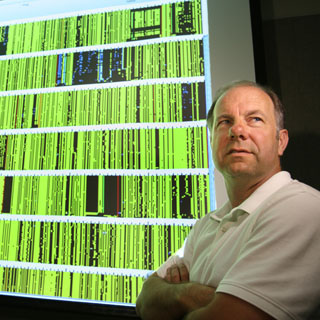
We often think of evolution as a slow, orderly process. Over generations, incremental genomic changes are passed from parent to child through the tree of life. Not so with bacteria — their form of evolution is more akin to paper trading on the floor of the New York Stock Exchange, with genes being swapped horizontally in a tree of life that would be better described as a tumbleweed.
We know about the “Wild West” environment of bacterial evolution thanks to genomic sequencing. “More than 6,000 bacterial genomes have been sequenced to date, so we’re beginning to get a really good picture of what they look like,” says staff bioinformaticist Kelly Williams (8623).
Bacteria have a slow mutation rate, about one in a billion changes per base pair per generation, but genetic change can, in fact, occur rapidly in these organisms because of their ability to swap genes horizontally via mobile DNA elements called genomic islands. Genomic islands are a focus of Sandia bioinformatics research because they are the main source of bacterial genes of interest to biodefense and bioenergy applications, such as pathogenicity genes underlying microbial virulence and biodegrading enzyme genes that could be tailored for use in the biofuels industry.
Shedding light on how islands move
In an LDRD project, Kelly is using comparative genomics to better understand the structure and content of genomic islands. His first step was to write a computer algorithm that aligns multiple bacterial genomes in chromosomal order for easy visualization of their mobile elements. He has used this algorithm to order and visualize 40 genomes of the bacteria Brucella, and is now moving onto Rickettsia and other bacteria of interest.
“It’s a quick, visual way to focus on the islands and begin in-depth analysis of island genomic sites and arrangements, as well as their phylogenetic distributions,” says Kelly. “This analysis will shed light on how islands move, evolve, and cooperate combinatorially to promote pathogenicity.”
Together with developing visualization tools, Kelly also is building a database of known pathogenicity islands and more basic reference databases for Sandia’s growing program in biology and bioinformatics. “The ultimate goal is to use this information to machine learn the ability to predict pathogenicity genes,” he says.
This is where Kelly’s research interest in bacterial evolution via genomic islands fits into Sandia’s broader national security mission. The understanding of how pathogenicity naturally evolves in bacteria can be used to identify unnatural evolution of pathogenicity, in other words, a synthesized bioweapon.
Bioengineering used to leave behind “toolmarks” that enabled researchers to identify engineered biological agents (EBA) as such. Today’s biosecurity challenge is that EBAs are more sophisticated and can escape such detection, but even in the “Wild West” there are still rules governing the horizontal gene transfer that occurs in genomic islands.
Kelly, together with collaborators Owen Solberg and Joe Schoeniger (both 8623), is working toward a computational tool to measure the “naturalness” of a suspect organism in terms of novel gene combinations.
“This is just one critical area where bioinformatics can aid in biodefense,” says Cathy Branda, manager of Systems Biology Department 8623. “We are harnessing the incredible amount of data made available by advanced genetic sequencing technology to further our understanding of basic biology, which in turn allows us to pinpoint certain processes like horizontal gene transfer.”
Makes sense to focus on genomic solutions
Sandia, like other research institutions, is developing a bioinformatics capability hand-in-hand with the technological revolution in genomic sequencing. “Sequencing has become so fast and sophisticated that it makes sense to focus on genomic solutions to problems in biodefense, energy, and the clinical world,” she says.
Kelly brings to Sandia deep expertise in phylogenetic characterization of sequence datasets. He earned his bachelor’s degree from the University of California, Santa Barbara in physiology and cell biology and his doctorate from University of California, San Diego in biology. Before joining Sandia, Kelly spent seven years as an assistant professor of biology at Indiana University and five years as a research investigator at the Virginia Bioinformatics Institute at Virginia Tech.
Kelly initially joined Sandia to work on the RapTOR Grand Challenge, which helped lay important groundwork in bioinformatics. “This is an area in which we’d all like to see Sandia grow,” says Cathy.